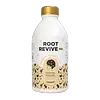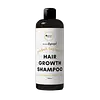What's inside
What's inside
 Key Ingredients
Key Ingredients

No key ingredients
 Benefits
Benefits

 Concerns
Concerns

 Ingredients Side-by-side
Ingredients Side-by-side

Rosmarinus Officinalis Water
MaskingPotassium Oleate
EmulsifyingPotassium Cocoate
EmulsifyingGlycerin
HumectantPhyllanthus Emblica Fruit Extract
HumectantSapindus Mukorossi Fruit Oil
Skin ProtectingTrigonella Foenum-Graecum Hydroxypropyltrimonium Chloride
Skin ConditioningMelia Azadirachta Leaf Extract
Skin ConditioningAcacia Concinna Fruit Extract
Skin ConditioningMentha Arvensis Herb Oil
PerfumingPhenoxyethanol
PreservativePotassium Citrate
BufferingCitric Acid
BufferingRosmarinus Officinalis Water, Potassium Oleate, Potassium Cocoate, Glycerin, Phyllanthus Emblica Fruit Extract, Sapindus Mukorossi Fruit Oil, Trigonella Foenum-Graecum Hydroxypropyltrimonium Chloride, Melia Azadirachta Leaf Extract, Acacia Concinna Fruit Extract, Mentha Arvensis Herb Oil, Phenoxyethanol, Potassium Citrate, Citric Acid
Water
Skin ConditioningPotassium Oleate
EmulsifyingPotassium Cocoate
EmulsifyingGlycerin
HumectantPhyllanthus Emblica Fruit Extract
HumectantSapindus Mukorossi Fruit Oil
Skin ProtectingTrigonella Foenum-Graecum Hydroxypropyltrimonium Chloride
Skin ConditioningMelia Azadirachta Leaf Extract
Skin ConditioningAcacia Concinna Fruit Extract
Skin ConditioningMentha Arvensis Callus Lysate
AntioxidantRosmarinus Officinalis Leaf
Skin ConditioningPhenoxyethanol
PreservativePotassium Citrate
BufferingCitric Acid
BufferingWater, Potassium Oleate, Potassium Cocoate, Glycerin, Phyllanthus Emblica Fruit Extract, Sapindus Mukorossi Fruit Oil, Trigonella Foenum-Graecum Hydroxypropyltrimonium Chloride, Melia Azadirachta Leaf Extract, Acacia Concinna Fruit Extract, Mentha Arvensis Callus Lysate, Rosmarinus Officinalis Leaf, Phenoxyethanol, Potassium Citrate, Citric Acid
Ingredients Explained
These ingredients are found in both products.
Ingredients higher up in an ingredient list are typically present in a larger amount.
We don't have a description for Acacia Concinna Fruit Extract yet.
Citric Acid is an alpha hydroxy acid (AHA) naturally found in citrus fruits like oranges, lemons, and limes.
Like other AHAs, citric acid can exfoliate skin by breaking down the bonds that hold dead skin cells together. This helps reveal smoother and brighter skin underneath.
However, this exfoliating effect only happens at high concentrations (20%) which can be hard to find in cosmetic products.
Due to this, citric acid is usually included in small amounts as a pH adjuster. This helps keep products slightly more acidic and compatible with skin's natural pH.
In skincare formulas, citric acid can:
While it can provide some skin benefits, research shows lactic acid and glycolic acid are generally more effective and less irritating exfoliants.
Most citric acid used in skincare today is made by fermenting sugars (usually from molasses). This synthetic version is identical to the natural citrus form but easier to stabilize and use in formulations.
Read more about some other popular AHA's here:
Learn more about Citric AcidGlycerin is already naturally found in your skin. It helps moisturize and protect your skin.
A study from 2016 found glycerin to be more effective as a humectant than AHAs and hyaluronic acid.
As a humectant, it helps the skin stay hydrated by pulling moisture to your skin. The low molecular weight of glycerin allows it to pull moisture into the deeper layers of your skin.
Hydrated skin improves your skin barrier; Your skin barrier helps protect against irritants and bacteria.
Glycerin has also been found to have antimicrobial and antiviral properties. Due to these properties, glycerin is often used in wound and burn treatments.
In cosmetics, glycerin is usually derived from plants such as soybean or palm. However, it can also be sourced from animals, such as tallow or animal fat.
This ingredient is organic, colorless, odorless, and non-toxic.
Glycerin is the name for this ingredient in American English. British English uses Glycerol/Glycerine.
Learn more about GlycerinMelia Azadirachta Leaf Extract is extract from the neem plant.
The leaves of this tree contain flavonoids and polyphenols. These two compounds are antioxidants, anti-inflammatory, and antibacterial. Further research is needed as to their effects when applied on skin.
Phenoxyethanol is a preservative that has germicide, antimicrobial, and aromatic properties. Studies show that phenoxyethanol can prevent microbial growth. By itself, it has a scent that is similar to that of a rose.
It's often used in formulations along with Caprylyl Glycol to preserve the shelf life of products.
This ingredient is also known as Indian Gooseberry. It is skin hydrating and antioxidant rich.
We don't have a description for Potassium Citrate yet.
This ingredient is the potassium salt of coconut acid. Coconut acid is created by mixing fatty acids from coconut oil.
It is an emulsifier, surfactant, and cleanser. According to a manufacturer, it contains glycerin.
We don't have a description for Potassium Oleate yet.
Sapindus Mukorossi Fruit Oil is an oil.
We don't have a description for Trigonella Foenum-Graecum Hydroxypropyltrimonium Chloride yet.